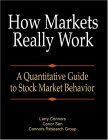
Product Description:
Anyone who wants to understand stock market cycles and develop a focused, thoughtful, and solidly grounded valuation approach to the stock market must read this book. Bolten explains the causes and patterns of the cycles and identifies the causes of stock price changes. He identifies the sources of risks in the stock market and in individual stocks. Also covered is how the interaction of expected return and risk creates stock market cycles. Bolten talks about the industry sectors most likely to be profitable investments in each stage of the stock market cycles, while identifying the stock market bubble and sinkhole warning signs. The role of the Federal Reserve in each stage of the stock market cycle is also discussed.

Product Description:
Published for the very first time ever. Over 850 practical, easy-to-use historical probabilities on the most commonly traded market scenarios!
For years, traders and investors have been using unproven assumptions about popular patterns such as breakouts, momentum, new highs, new lows, market breadth, put/call ratios and more without knowing if there is a statistical edge.
Have you ever wondered the following...
Do these patterns actually make you money? Read on and you'll be surprised by what 15 years of new, previously unpublished research reveals.
Is there a radically different, better way to trade these patterns and indicators that somehow has escaped the awareness of traders and investors? You'll find the answers below...
The answers to both of these questions and much more is contained in Larry Connors' new book, How Markets Really Work. Through new research, much of which has never before been published, you will be able to clearly see which of nearly 850 meticulously researched patterns and indicators have an edge -- and which do not. Best of all, you will be able to apply this information whenever you trade.
Here's how you can use How Markets Really Work in your trading every day. Learn how to focus on trades that have the best edge and stop trading setups that have zero edge. Every time you trade, just look up the current market action in the book so that you can potentially maximize your winning trades while weeding out the losing ones.
Gain an edge that many traders and professional traders do not have. Most traders will continue to operate according to incorrect conventional wisdom because much of it "seems to make sense." But by using How Markets Really Work as your daily reference guide, you will be able to take advantage of market behaviors that consistently repeated themselves over and over again in the past.
Use it to better time your entries and exits into stocks and ETFs. Many times the trading system or methodology you are using will tell you to enter or exit a trade into price action that matches one of the patterns listed in How Markets Really Work. When this occurs, it's a great opportunity for you to fine tune your actions so that statistical probabilities are working in your favor and not against you.
The knowledge contained in How Markets Really Work can be used in developing your very own systems and strategies. Whether you are a system developer or you just want to improve your existing trading strategy, you can use the core knowledge in this book to stimulate your own research and create new systems.
Impact your trading with never-before-seen research on put/call ratios, price movement, breadth indicators, large one-day moves, volume and much, much more. Whether you use these indicators or not, you will finally be able to make informed decisions about their true value to your trading. Each Chapter Of How Markets Really Work Is Backed By Up To 15 Years Of Historical Results!

Product Description:
The scientific study of complex systems has transformed a wide range of disciplines in recent years, enabling researchers in both the natural and social sciences to model and predict phenomena as diverse as earthquakes, global warming, demographic patterns, financial crises, and the failure of materials. In this book, Didier Sornette boldly applies his varied experience in these areas to propose a simple, powerful, and general theory of how, why, and when stock markets crash.
Most attempts to explain market failures seek to pinpoint triggering mechanisms that occur hours, days, or weeks before the collapse. Sornette proposes a radically different view: the underlying cause can be sought months and even years before the abrupt, catastrophic event in the build-up of cooperative speculation, which often translates into an accelerating rise of the market price, otherwise known as a "bubble." Anchoring his sophisticated, step-by-step analysis in leading-edge physical and statistical modeling techniques, he unearths remarkable insights and some predictions--among them, that the "end of the growth era" will occur around 2050.
Sornette probes major historical precedents, from the decades-long "tulip mania" in the Netherlands that wilted suddenly in 1637 to the South Sea Bubble that ended with the first huge market crash in England in 1720, to the Great Crash of October 1929 and Black Monday in 1987, to cite just a few. He concludes that most explanations other than cooperative self-organization fail to account for the subtle bubbles by which the markets lay the groundwork for catastrophe.
Any investor or investment professional who seeks a genuine understanding of looming financial disasters should read this book. Physicists, geologists, biologists, economists, and others will welcome Why Stock Markets Crash as a highly original "scientific tale," as Sornette aptly puts it, of the exciting and sometimes fearsome--but no longer quite so unfathomable--world of stock markets.
Summary: Index